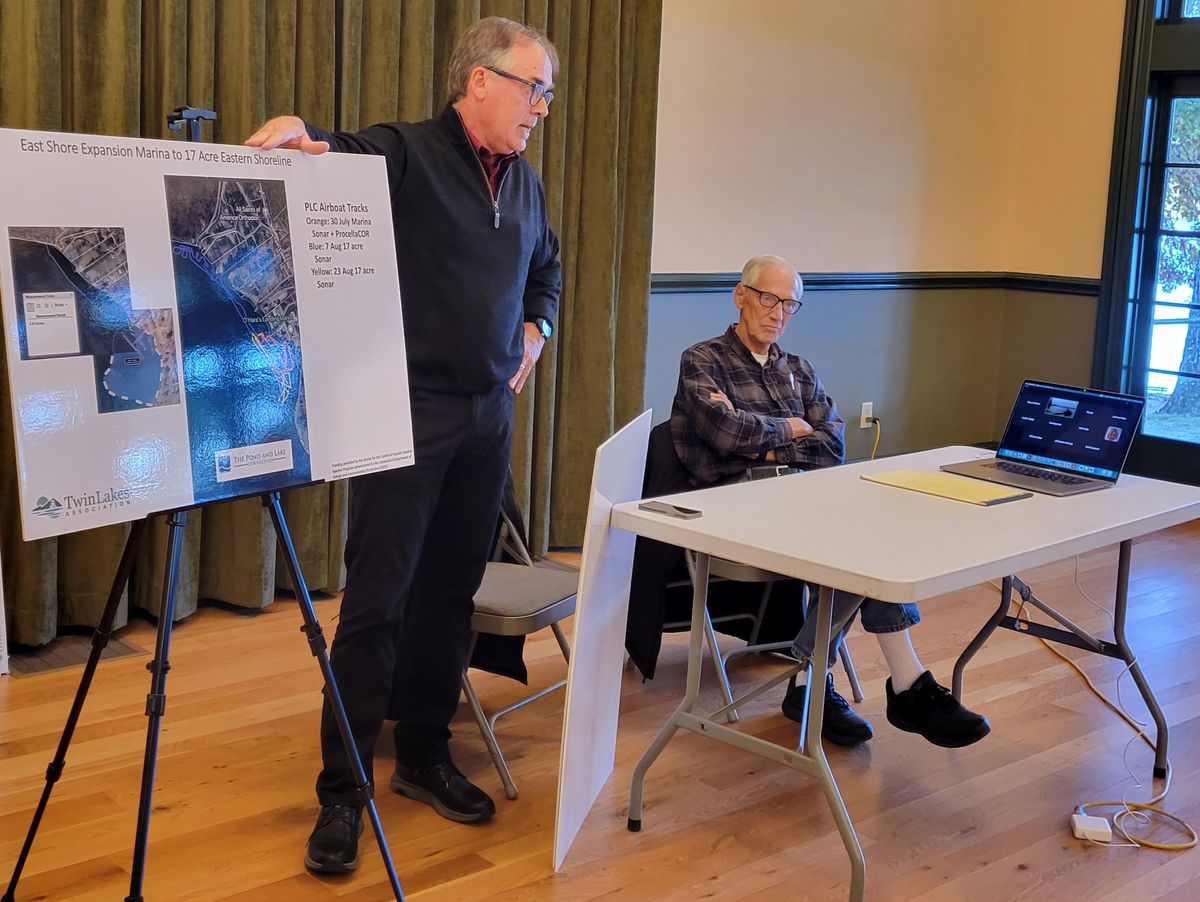
TLA President Grant Bogle, left, and Bill Littauer, president of the Lake Wononscopomuc Association, addressed stakeholders during an Oct. 10 forum at the Salisbury Town Grove.
Debra A. Aleksinas

TLA President Grant Bogle, left, and Bill Littauer, president of the Lake Wononscopomuc Association, addressed stakeholders during an Oct. 10 forum at the Salisbury Town Grove.
“In three years, we will have spent over a million dollars to manage this, but if we don’t, we lose this lake.”
—Grant Bogle, Twin Lakes Association president
SALISBURY — As if on cue, the setting sun at Lake Wononscopomuc signaled the end of the day and hope for a new tomorrow, a fitting backdrop to the group of lake representatives that had gathered on Oct. 10 at the Town Grove to pool resources, share information and discuss management plans in the ongoing threat from invasive hydrilla.
During the nearly two-hour forum, Bill Littauer, president of the Lake Wononscopomuc Association, and Grant Bogle, president of the Twin Lakes Association (TLA), addressed an audience of about 50 stakeholders, including property owners, representatives of nearby Mt. Riga, Inc., and town officials.
“Hydrilla, I’m told, was named after Hydra, the nine-headed monster of Greek mythology,” known to regenerate two heads for every one that was cut off, said Littauer. “So that is very germane to this discussion.”
Littauer explained that the hydrilla verticillata which found its way into Florida through the aquarium industry in the 1950’s is not the same strain that has devastated coves and tributaries throughout the Connecticut River since 2016.
“It has morphed and created a much more virulent strain known as the Connecticut River variant, because that’s where all of the problems stem from. You just can’t kill the stuff,” noted Littauer. He said sea planes and fishing boats likely contributed to its inland spread.
A more aggressive approach in 2025
In June of 2023, East Twin Lake became the first lake outside of the Connecticut River to identify the presence of hydrilla, and the TLA immediately assembled a coalition of scientific and environmental advisers to address the threat.
As a precaution, Lake Wononscopomuc, also known as Lakeville Lake, immediately closed its launch to outside boaters, and Mt. Riga, Inc. also played it safe by closing its Ostrander beach and campsites this past season until preventative measures were in place.
Despite two summers of herbicide spot treatment mainly around the marina at East Twin, hydrilla has migrated to deeper waters, prompting the TLA to take a more aggressive approach in the spring of 2025 by treating the lake’s entire littoral zone with multiple doses of the herbicide SonarOne.
So far, Littauer said, hydrilla has not been found in Lakeville Lake, and keeping it out is the primary goal, which is why its boat launch will remain closed indefinitely.
“Unfortunately for us on Wononscopomuc, the only alternative should hydrilla find its way into the lake, is herbicides, and we have had such opposition on this lake” to chemical treatment, even for milfoil, he explained. “I shudder to think that is the only solution.”
Bogle explained that at Twin Lakes, in addition to a more aggressive approach to controlling the invasive weed on East Twin, “our goal is to stop hydrilla from getting into West Twin. We’re chasing the plant at this point in time, but we’re not down and out by a long shot. We’ve made real progress this year.”
But the chase comes at a cost. In 2021, lake management costs were about $50,000 for the Twin Lakes. “We are spending roughly $300,000 this year and project spending $350,000 next year,” the TLA president told those assembled.
“In three years, we will have spent over a million dollars to manage this, but if we don’t we lose this lake.”
The TLA has launched a year-end appeal to raise $250,000 for hydrilla control next year and to eventually eliminate the noxious weed.
Chemical treatment carries hefty price tag
According to the TLA, projected lake management costs next year will exceed $350,000, a seven-fold increase from just four years ago and a figure that will remain elevated for years. More than nine in every 10 dollars raised gets spent directly on lake management.
The town of Salisbury has traditionally picked up two-thirds of the lake management costs but lacks the resources to sustain that share at current spending levels, according to TLA officials.
In response to an audience question about why management of hydrilla is so expensive, Bogle noted that while herbicides are relatively low-cost, it takes a crew of trained and licensed professionals to apply the treatments to the tune of about $2,500 per application.
Discussion also centered around the need for all lakes to have an emergency plan should hydrilla take root, since approvals for treatment from the state Department of Environmental Protection (DEEP) could take several months and hydrilla can double in biomass every day during the height of the summer growing season and can quickly outcompete native plant species.
“In the event it was found, we’d go very forcefully to DEEP to ask their permission to use the herbicides,” Rand explained.
Bogle credited DEEP for becoming “a partner with us, and that was not true two years ago. What happened to Twin Lakes is unfortunately going to happen elsewhere and they’re trying to learn, too.”
Preparing for worst-case scenario
Discussion centered around the importance of lake groups creating a management plan in preparation for a worst-case scenario.
“There are things that can be done to get ready. Active monitoring and having a plan I think will be helpful,” Bogle noted.
Other strategies Twin Lakes will be putting into place next season is to increase hours for the boat monitors at the marina, and possibly adding a boat-washing station.
In closing the meeting, Bogle praised the camaraderie among the lakes’ stakeholders, all of which face unique challenges.
“I think it’s been a positive benefit. We are all in our own little bubbles and I think it has been helpful to have this type of discussion. Each lake is different, and each lake community is different.”
Sharon Center School
SHARON — A Sharon Center School staff member discovered a “facsimile firearm” behind a file cabinet around 2 p.m. on Wednesday, Dec. 10, prompting an immediate response from State Police and a same-day notification to parents, according to Region One Superintendent Melony Brady-Shanley.
Brady-Shanley said in an email to families that, upon the item’s discovery, “The State Police were immediately notified and responded to the building.”
A canine team was brought in to sweep the building to confirm no additional items were present, “and the building has been fully cleared. The State Police consider this an isolated incident and not criminal in nature,” Brady-Shanley stated.
State Police explained, “Troopers from Troop B - North Canaan were dispatched to the Sharon Center School for reports of a firearm located in a closet. The firearm was determined to be a non-firing, replica firearm... There was no threat to the school or the public.”
Brady-Shanley emphasized “the safety and well-being of our students and staff remain our highest priority at all times. We will continue to follow and strengthen our safety protocols to ensure that our schools remain secure, supportive environments for learning.”
The Stone Round Barn at Hancock Shaker Village.
My husband Tom, our friend Jim Jasper and I spent the day at Hancock Shaker Village in Pittsfield, Massachusetts. A cold, blustery wind shook the limbs of an ancient apple tree still clinging to golden fruit. Spitting sleet drove us inside for warmth, and the lusty smells of manure from the goats, sheep, pigs and chickens in the Stone Round Barn filled our senses. We traveled back in time down sparse hallways lined with endless peg racks. The winter light was slightly crooked through the panes of old glass. The quiet life of the Shakers is preserved simply.

Originally founded in England, the Shakers brought their communal religious society to the New World 250 years ago. They sought the perfection of heaven on earth through their values of equality and pacifism. They followed strict protocols of behavior and belief. They were celibate and never married, yet they loved singing and ecstatic dancing, or “shaking,” and often adopted orphans. To achieve their millennialist goal of transcendental rapture, we learned, even their bedclothes had to conform: One must sleep in a bed painted deep green with blue and white coverings.
Shakers believed in gender and racial equality and anointed their visionary founding leader, Mother Ann Lee, an illiterate yet wise woman, as the Second Coming. They embraced sustainability and created practical designs of great utility and beauty, such as the mail-order seed packet, the wood stove, the circular saw, the metal pen, the flat broom and wooden clothespins.
Burning coal smelled acrid as the blacksmith fired up his stove to heat the metal rod he was transforming into a hook. Hammer on anvil is an ancient sound. My husband has blacksmithing skills and once made the strap hinges and thumb latches for a friend’s home.
Shaker chairs and rockers are still made today in the woodworker’s shop. They are well made and functional, with woven cloth or rush seats. In the communal living space, or Brick Dwelling, chairs hang from the Shaker pegs that run the length of the hallways, which once housed more than 100 Shakers.

In 1826, the 95-foot Round Stone Barn was built of limestone quarried from the land of the 3,000-acre Hancock Shaker Village. Its unique design allowed a continuous workflow. Fifty cows could stand in a circle facing one another and be fed more easily. Manure could be shoveled into a pit below and removed by wagon and there was more light and better ventilation.
Shakers called us the “people of the world” and referred to their farm as the City of Peace. We take lessons away with us, yearning somehow for their simplicity and close relationship to nature. One Shaker said, “There’s as much reverence in pulling an onion as there is in singing hallelujah.”
A sense of calm came over me as I looked across the fields to the hills in the distance. A woman like me once stood between these long rows of herbs — summer savory, sage, sweet marjoram and thyme — leaned on her shovel brushing her hair back from her eyes, watching gray snow clouds roll down the Berkshires.
More information at hancockshakervillage.org

Exterior of Lakeville Books & Stationery in Great Barrington.
Fresh off the successful opening of Lakeville Books & Stationery in April 2025, Lakeville residents Darryl and Anne Peck have expanded their business by opening their second store in the former Bookloft space at 63 State St. (Route 7) in Great Barrington.
“We have been part of the community since 1990,” said Darryl Peck. “The addition of Great Barrington, a town I have been visiting since I was a kid, is special. And obviously we are thrilled to ensure that Great Barrington once again has a new bookstore.”
The second Lakeville Books & Stationery is slightly larger than the first store. It offers more than 10,000 books and follows the same model: a general-interest store with a curated mix of current bestsellers, children’s and young readers’ sections; and robust collections for adults ranging from arts and architecture, cooking and gardening, and home design to literature and memoirs. Anne reads more than 150 new titles every year (as many as a Booker Prize judge) and is a great resource to help customers find the perfect pick.
A real-time inventory system helps the store track what’s on hand, and staff can order items that aren’t currently available. There is also a selection of writing and paper goods, including notecards, journals, pens and notebooks, as well as art supplies, board games, jigsaw puzzles and more. The owners scour the stationery trade shows twice a year and, Darryl says, “like to tailor what we offer to suit the interest of our customers in each market.”
The Pecks know what it takes to run a successful local enterprise. Darryl has a 53-year background in retail and has launched several successful businesses. He and Anne owned and operated a bookstore on St. Simons Island, Georgia, from 2019 to 2025. They are tapping into their local roots with both stores. They raised their family in Sharon, and their daughter Alice, a native of the Northwest Corner, manages the Lakeville store.

The family values the role that a retail store plays as a supporting partner in the community, and they prioritize great management in both locations, hiring and training talent from local communities. Their 10 team members across both stores are from the area, and two of the Great Barrington employees previously worked at Bookloft.
Darryl and Anne’s attention to customer service is everywhere apparent and adds to the enjoyable and irreplaceable in-store shopping experience. The books are in pristine condition, eliminating the risk of damage that sometimes occurs during shipping. This is especially important for books that will live on people’s shelves and coffee tables for years.
Darryl says, “People love the in-store discovery — you find books you didn’t know existed, which is very difficult to do on a website. Also, many customers depend on our recommendations when visiting. There is a saying about bookstores versus online ordering: We may not have exactly what you were looking for, but we have what you want.”
Lakeville Books & Stationery’s Great Barrington store is open 7 days a week, Monday-Saturday, 10 a.m. to 6 p.m., and Sunday, 11 a.m. to 5 p.m. Parking is available in the lot behind the building and in the parking lot behind the firehouse. The entrance to the store is accessible from the store parking lot.
For more information, go to lakevillebooks.com., and sign-up for the Lakeville Books newsletter.
Richard Feiner and Annette Stover have worked and taught in the arts, communications, and philanthropy in Berlin, Paris, Tokyo and New York. Passionate supporters of the arts, they live in Salisbury and Greenwich Village.